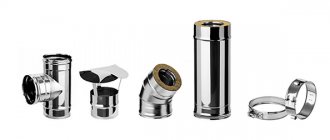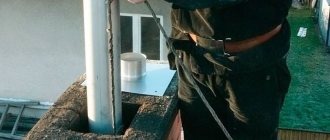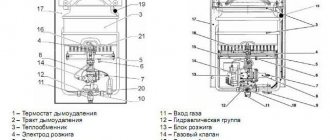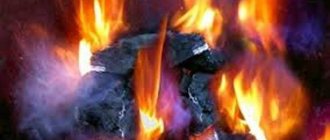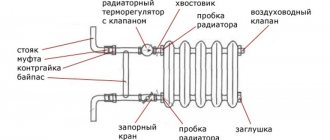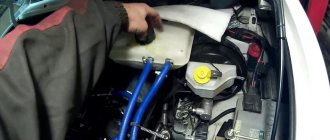Causes of plaque on the chimney
Combustion waste accumulates in the chimney for various reasons. For example, one of the reasons may be the design of the chimney. If a direct-flow channel is provided for the exit of smoke, then soot and soot accumulate slowly in it, since the speed of passage of gases is high and deposits do not have time to hit the inner surface.
But such exhaust channels are rarely used; most often, chimneys are used in the form of a labyrinth , which are created to slow down the emission of smoke and greatly heat the walls of the chimney.
The efficiency of heating the room increases, but this design leads to a large deposition of soot on the walls of the chimney, and it is difficult to clean it due to the large number of turns. Chimneys of this type are equipped with special inspection hatches for cleaning soot.
Wrong fuel
It is known that in order for the stove to burn hot and provide warmth, the wood must be dry or have no more than 20% humidity. But this is not always the case in practice, which leads to incomplete combustion and particles entering the chimney, where they are deposited.
Resinous wood species produce a lot of deposits; sometimes wood that has been used and has acquired negative qualities is thrown into the oven. For example, old parquet that was removed from the floor to be replaced. They throw it into the firebox, not thinking about the fact that it is covered with resin and varnish.
Often the furnace vent is used to burn household waste. But if we are talking about cardboard and paper, then this is normal, which cannot be said about disposable tableware, plastic bottles, plastic bags and other similar human waste . When burned, chemicals release products that spoil the inside of the chimney, depositing on its walls.
Damage to masonry and poor quality material
The chimney can be made of brick, ceramics, metal and asbestos. The last two steadfastly resist decomposition from the effects of combustion products. The brick, despite the fact that it is fired, is gradually destroyed by the action of gases and acids.
This leads to the appearance of significant roughness on the inner walls . The smoke, passing through the smoke channel, gradually clings to irregularities, its speed decreases, therefore, the rapid release of combustion products does not occur.
When laying a chimney, stove makers try to lay the brick with the smooth side inward, but no matter how hard they try, the stove chimney gradually loses its smoothness . In addition, when laying, sometimes the standards for preparing the mortar are not followed, it dries out, the pipe cracks, which allows soot deposits to accumulate in the resulting irregularities.
Cracks are fire hazards; at high combustion temperatures in a furnace, hot gases and soot burning on the walls can fly out and cause a fire , for example, in floor or roofing materials.
Reasons for its appearance and what it means
The reasons for the formation of soot in the chimney can be very different, and often this is a consequence of improper operation of the stove device. Let's list the most common causes:
- Using raw firewood or fuel briquettes.
- Incorrect chimney configuration, preventing the normal passage of smoke.
- A large number of irregularities on the inside of the pipe.
- Pollution and littering of the chimney during the time when it is not in use.
- Burning various household waste and especially plastic in a furnace.
- Frequent change of wood species burned in the firebox.
In fact, these are not all the causes of soot, but they are the most common.
Advice! To fire a stove or fireplace, you need to use only well-dried firewood, aged for at least one and a half years.
How to find out about the need for chimney cleaning
If you do not clean the chimney, the roughness of the walls becomes greater, and the force of air friction on the side surfaces increases. The traction force is spent on overcoming this resistance and, as a result, the rate of release of combustion products decreases and the air consumption for heating decreases.
The temperature in the firebox drops and the house becomes cold . Instead of cleaning the channel, the owners of a private house begin to add fuel. All of the above reasons lead to a violation of traction, which is manifested in the following performance indicators:
- The amount of heat in the house remains constant, but more fuel is required to achieve this.
- Hot gases can cause soot in the pipe to ignite and lead to a fire.
- Burning soot emits black smoke visible from the chimney, and absolutely dry fuel can be loaded into the stove.
- The color of the flame turns into a dark red hue, which indicates a lack of fresh oxygen due to reduced draft.
The chimney in the house should be cleaned only if it removes solid fuel combustion . When gas fuel is burned in a chimney, other problems arise related to the formation of condensation.
The norm is to clean the chimney from soot once a year , this is done in any way at the beginning and end of the season, which prevents major cleaning or even disassembly of the chimney pipe.
Consequences of soot accumulation
Often, homeowners neglect cleaning the chimney, and in vain, since in addition to the basic deterioration of draft, this can lead to a number of sad consequences, some of which can not only cause harm to health, but can also lead to death.
We are now talking about the absence of draft and penetration of carbon monoxide into the room. Its danger lies in the fact that, unlike smoke, which has a characteristic odor, carbon monoxide has no odor at all, but at the same time it is deadly to health and life. But that’s not all, here are just a few possible scenarios for the development of events with a clogged chimney.
- The soot that accumulates in the chimney can sooner or later flare up and with poor brickwork, high temperatures can lead to a fire in the roof, as shown in the photo above.
- The narrower the chimney passage, the more sparks escape from the tip. In strong winds, both the roof itself and the surrounding buildings may catch fire.
- ignition of soot in the chimney can lead to strong backdraft, as a result of which the fire will go inside the room and it will be very difficult to stop it.
- A thick layer of soot will accelerate the wear of the brickwork.
- Carbon deposits prevent uniform heating of the fireplace and chimney, resulting in a significant reduction in the efficiency of the device.
These and many other factors sooner or later make every homeowner wonder how to deal with soot in the chimney, and this is what will be discussed below.
Important to remember! Experts advise carrying out preventive cleaning of the chimney at least twice a year; this will not only extend the life of the stove or fireplace, but will also allow you to clean it yourself quickly and without much difficulty.
What are the methods for cleaning a chimney?
To clean a chimney pipe, you can resort to several methods:
- folk remedies;
- use modern chemicals;
- ignite the chimney;
- mechanically remove soot deposits.
Using the first three methods, you can clean channels that have a slight degree of contamination. But if the walls of the chimney are overgrown with soot, then the mechanical method will be just right. The first two ways to clean the channel are to place a chemical or folk remedy and set it on fire.
Substances released during combustion actively decompose pollution. Some of the soot in the form of flakes escapes from the pipe and falls down onto the courtyard, the rest falls down to the channel bottom. Although calcining a chimney
Calcination is the burning of soot in a chimney due to the high combustion temperature. To do this, the furnace or boiler must be forced to operate at full power, which is ensured by supplying the greatest amount of oxygen. After heating, gases heated to a temperature of 600ºC cause soot to burn in the chimney and clean it.
The method requires a preliminary check of the integrity of the smoke channel , which can collapse over time; even simple rodents can make a contribution. Fire hazardous materials may ignite through openings.
Mechanical way to clean a chimney duct
This difficult task will become simple if you familiarize yourself with the information presented in this article. Before cleaning the stove, you should remove from the firebox all items that are poorly secured and may interfere. The stove and hob, if any, are covered with thick cellophane or cloth and secured with a weight.
You need to start cleaning the chimney from the bottom; for this, use special brushes and brooms . After freeing the accessible part of the pipe, clean the chimney from the roof side. To do this, you need to secure yourself with a mounting belt, and using a sinker, try to push or pull out the layers of soot in or out.
If a lot of debris and soot accumulates in front of the stove, you can get rid of it with a vacuum cleaner or a broom and dustpan. This type of work is usually performed by men, as it requires some effort.
Soot can be considered the main enemy of a chimney; it reduces draft and gradually destroys the pipe. If soot begins to burn, then not all channel materials can withstand such heat.
Chimney cleaning with potato peelings
To clean the oven in this way, it is melted, then potato peelings are placed on the fire. The peel is pre-dried so that it burns well in the oven. The cleanings are placed in a container the size of a bucket and kept for several days. After this cleaning is ready for use in the form of a cleanser.
During combustion, cleaning products release starch, which destroys soot upon contact with it. If the work is done correctly, then within a few days the soot will fall out of the chimney in pieces, falling into the firebox. To clean the chimney faster, you can use mechanical cleaning items.
Using salt to get rid of soot
This method is more suitable as a preventive method for removing soot deposits, which it is advisable to use constantly. Salt is poured in an amount depending on the size of the stove onto the hot fuel.
When burning, salt particles will react with oxygen molecules and destroy the soot in the pipe . The effectiveness of the measures taken depends on the choice of salt quality, but you can choose the right substance by trying this cleaning several times.
How to reduce chimney pollution?
It is common for different types of heating devices to accumulate soot in the smoke ducts at different rates. So, the more protrusions, roughnesses and irregularities, the more soot settles on the walls. Numerous turns or improperly laid smoke channels also prevent soot from escaping into the atmosphere.
But if the stove, fireplace, boiler are already installed, then there is no way to change its design. But you can minimize other negative factors that lead to severe contamination of the chimney.
Choosing the optimal fuel
When any fuel burns in a chimney, a deposit of soot and soot forms. But one type can form more deposits than others. The intensity of pollution can be reduced if you use the “right” fuel.
Wood from different tree species has different chemical composition. Different contents of resin, oils, tar, and creosote affect the degree of sediment formation on chimney pipes. The less these substances are in the wood, the less soot will be formed during the combustion process. Other types of solid fuels also contribute to pollution to varying degrees.
Which fuel produces soot more strongly than others:
- firewood from coniferous species - spruce, pine;
- birch firewood, which has a high tar content;
- Briquettes and pellets made from seed husks, due to their high oil content, produce intensive soot formation.
It should also be said that burning household waste, especially plastic, in a stove also contributes to the formation of plaque.
In contrast to these types of fuel, firewood from oak, hornbeam, beech, walnut, sycamore, pear, and apple can be noted. These hard rocks are much less likely to cause contamination of smoke ducts.
Aspen firewood produces little soot, and, in addition, is a preventive measure in the fight against its deposition on the walls of the chimney
Briquettes made from sawdust, otherwise called Euro-firewood, burn well and leave a little soot behind. When burning, they do not spark, and weakly absorb moisture, so they can be stored in kitchens next to the stove.
Dependence on humidity and combustion temperature
It is highly advisable to use dry wood for heating premises - the drier the better. The fact is that when wet fuel is burned, the ash, under the influence of steam, rises with it and sticks together into lumps. It becomes heavier and cannot leave the chimney. As a result, it accumulates inside the chimney in the form of soot.
Therefore, they need to be prepared in advance and stored under a canopy, in special covered premises, sheds. In such conditions, it will be possible to achieve 15-20% humidity. In this case, the degree of dryness will always fluctuate depending on the air humidity indoors and outdoors.
The more water vapor is formed during the combustion of fuel, the faster blockages form in the chimney, combustion chamber of the stove, boiler, fireplace
The amount of soot formation is also affected by the combustion temperature. The worse the firewood burns, the greater the degree of contamination, the more often the chimney will have to be cleaned.
This is due to the fact that at low temperatures an excess of carbon particles is formed, which settles in the form of soot and soot. This phenomenon is especially typical for the initial combustion, when the wood is just starting to burn.
Therefore, when lighting a stove or fireplace, you need to strive to increase the temperature in the firebox as quickly as possible - heat the stove with dry wood, use more thin and dry wood chips.
In addition, after the fire dies out, it is necessary to maintain heat. To do this, as soon as all the fuel has burned out in the stove, close the gate. And then, during the next kindling, the temperature inside the stove will be much higher than if it had not been closed.
The combustion temperature can be determined using a special device - a combustion indicator, which is attached to a metal chimney and measures the temperature of the flue gases
Traditional recipes for burning soot
We can say with confidence that these means of cleaning channels for removing combustion products are dangerous and not every chimney can withstand this. Cracks appear in the walls of the chimney due to high temperature; sometimes it is better to use other means for cleaning.
Walnuts and aspen . Walnut shells have the amazing property of high heat transfer. Therefore, to clean the chimney, you need to place about two-liter jars of shells in the firebox. This product will make the rising smoke as hot as possible, which will burn the soot in the chimney.
Aspen was an accessible material in the northern and middle regions of Russia, so it was used quite widely. This method is one of the best for cleaning , but against the backdrop of modern chemicals it is undeservedly forgotten. When burning aspen logs, all stove valves and doors should be closed.
After combustion, white flakes begin to fly out of the chimney, which are a product of soot combustion. The stove will make a loud noise and the soot will burn out completely , but the cleaning method is dangerous for weak chimneys.
Chimney cleaning with mothballs
Before using this method, you must ensure the following:
- There are no cracks, damage or holes on the outside of the chimney; if any are found, they are carefully sealed with mortar and allowed to dry.
- Make sure that no objects or work items accumulate in the channel passage.
Naphthalene for small stoves in a private home is used in the amount of one tablet, which is thrown onto the burning fuel . Soot, as in the case of aspen, will fly out in white flakes.
Naphthalene is a substance with a crystalline structure with a sharp, characteristic odor; sometimes, when used as a chimney cleaner, it explodes, which can lead to destruction of the pipe and subsequent fire.
Means for cleaning chimneys from soot
There are different types of chimney cleaning products based on chemical compounds. The most popular drug options:
Czech "Kominicek"
The drug goes on sale in the form of small sachets. There are 14 pieces in total in the package; the product is enough for 3 months of active prevention. The principle of operation of the chemistry is simple: when it gets into the chimney, it causes a catalytic reaction, splits the soot and turns it into oxide.
In turn, the oxide burns at a low temperature and does not form fire during combustion. Using this product you can get rid of soot in the chimney, a layer of which is about 2 millimeters. It’s easy to work with the product: open the bag and pour it into the firebox over firewood, coal, or whatever you use to heat the stove, and close the firebox. The product will do all the work for you.
Log "Chimney Sweep"
The product is sold in briquettes resembling firewood. It is easy to work with, just like with the previous product. It is enough to throw it into the fire and close the firebox tightly. During combustion, the material releases volatile gas. Inside the chimney, the gas dries soot and deposits, in turn they lag behind the walls of the pipe and crumble.
If you light a stove at the dacha and don’t come here often, then you can clean the chimney in this way once every 6 months. If the stove is used for heating every day, the chimney needs to be cleaned 2 times throughout the heating season.
While working with the product, it is taken out of the pack, but the packaging is left. It is effective to place the log on top of the hot coals. Make sure the product burns completely. The activity of chemical enzymes will remain for 1-2 weeks. During this period, soot will actively fall off the walls and end up in the firebox, in special containers.
Afterwards, inspect the chimney for any remaining soot and remove it with a brush. Before working with logs, check for debris or bird nests in the chimney. They may cause a fire. In general, the product helps to get rid of soot in the chimney without involving specialists.
Product "PHK"
This name hides the powder used to clean the chimney of soot. It is thrown into the oven, the firebox is closed and burned to ashes. The product can be used either together with firewood or separately from it. The preparation is calculated in such a way that there are about 200 grams of powder per ton of fuel.
Before using chemical chimney cleaning, carefully read what is written on the product. Some compounds are used only for cleaning fireplaces or wood-burning stoves. The preparations listed above are intended for universal pipe cleaning.
Cleaning if the pipe lumen is completely blocked
To do this, pour water (about three liters) into the chimney from above. After this, steam is released, which cleans the hole in the pipe. Soot flies out of the chimney in a compacted cloud of thick consistency. To prevent a chimney made of steel from rusting, they immediately begin to heat it and warm it up until the last moisture evaporates.
There are special cleaning logs or pellets , which are placed in the stove without opening the packaging, and the combustion lasts for about two hours. After this, the accumulation of soot and soot in the channel becomes loose, the separated light particles rise, and the heavy ones fall down into the firebox.
If special inspection holes are provided along the chimney, it is recommended to carry out preventive cleaning after using cleaning logs. There are special powders for cleaning the furnace outlet channel, for example, a Czech product called Kominichek, Smoke-Glas and others.
For their use instructions have been developed that will tell you how to use them correctly and what dosage to use. But all of them are used in the furnace to produce a chemical reaction, which results in substances that destroy the soot layer in the pipe.
In conclusion, it should be said that the smoke duct should be cleaned in any case, so that the misfortune of poor combustion of the stove is not added to the grief of sudden smoke in the room or a fire in the attic, where a pipe clogged with soot passes through.
Traditional methods of chimney cleaning
Traditional methods are aimed more at preventing the formation of tar deposits. If the chimney is clearly dirty, they are ineffective, and some of them can cause a fire. Therefore, old-fashioned methods should be treated with a reasonable degree of skepticism and the remark that the main condition for cleaning is safety.
Self-cleaning: what to add to the firebox
Below are suggested methods, the implementation of which does not cause concern. Their essence boils down to the use of substances, the combustion of which improves the separation of soot from the walls of the “smoke chamber”.
Method 1. Table salt. A thin layer of ordinary salt is poured onto the burning logs. Sodium chloride vapor “breaks” sticky deposits on the chimney.
Burning salt will partially prevent and slow down the formation of tarry deposits. The “salt method” is not able to cope with old soot growths
Method 2. Potato peel. An excellent and affordable tool. Potato peelings must first be dried. Depending on the size of the oven, 0.5-1 bucket of peel is added to the firebox. Alternatively, you can use the potatoes themselves, cut into slices and dried in the sun.
The release of starch when potatoes are burned softens the soot buildup. Some of the dirt disappears, and the remaining carbon deposits are easier to clean mechanically
Method 3. Hot water. This option is suitable for initial cleaning and breaking through a heavily clogged chimney. 3-4 liters of boiling water are poured from above the pipe, carefully distributed along the walls of the channel.
Evaporation softens the solid fractions of the plaque - soot begins to fly out of the chimney in flakes along with the smoke. The method helps remove the unpleasant burning smell
Method 4. Aluminum cans. An unusual, but quite effective option for cleaning a chimney. The essence of the method is that aluminum actually burns, and not just smokes and changes color at high temperatures. It is optimal if the can burns out in 5 minutes.
The method is applicable for heating systems using coal and wood. The frequency of preventive measures is 1 time per 10 fireboxes
Burning soot with fire is a risky option
An old way to clean a chimney is to burn aspen wood. Logs are placed in the oven and set on fire. It is necessary to achieve high, but short-term heat, which will lead to the combustion of soot.
When ignited, the furnace begins to hum, and fiery arrows can fly out of the chimney; the surrounding area is covered with white flakes. The result is a clean chimney.
Not every chimney will withstand the test of fire, since the soot in the channel burns out at a temperature of +1100°C. Flying sparks can cause a fire
Despite the assurances of some stove makers that burning soot is safe, resorting to this method is highly discouraged. However, aspen can be successfully used as a preventive measure - it is enough to throw 2-3 kg of alder or aspen logs into the stove from time to time after finishing the fire.
We suggest that you familiarize yourself with additional information about the means and methods for cleaning smoke ducts set out in the recommended article.
How to burn off soot in a chimney
One of the most popular and widely known methods of cleaning a chimney is the use of fire, or rather, the phenomenon of combustion. Not every owner of a country house in the country knows how to burn soot in a chimney safely. Of course, there is no absolutely safe and harmless cleaning method, however, radically reducing the degree of risk is an easily achievable task, the main thing is to set it for yourself.
From a practical point of view, soot is the most negative result of the constant operation of a chimney. Today, the modern progress of science has invented many different methods of cleaning a chimney, each of which has a certain set of advantages and disadvantages. However, it should always be objectively understood that the better the chimney is cleaned, the safer its subsequent continuous operation will be. (See also: How to clean soot from a chimney)
Before reaching the above situation, it is necessary to choose not only the fastest and highest quality method, but also take into account all the risks and ultimate advantages of a particular method. Of course, there are a huge number of different cleaning methods, but they are all divided into several large groups, namely:
for chemical reagents;
special engineering and structural devices;
So, to create a flame, it is enough to set fire to several armfuls, the main thing is that they are located in close proximity to each other. The second point that you should definitely pay attention to is safety; the house needs to be well ventilated. Since there is a possibility of accumulation of various combustion end products, inhalation of which can lead to a number of negative consequences.
It is necessary to clean the chimney extremely carefully, since otherwise, there is a very significant probability of a variety of negative consequences, some of them: (See also: How to repair a stove with your own hands)
loss of consciousness by persons who are in the house;
unintentional house fire;
poisoning by combustion products or cleaning chemicals;
injury during mechanical cleaning, etc.
Of course, there is no ideal way to dispose of soot and it is unlikely that it will ever appear, however, at the moment there are many highly effective and almost completely safe methods. For example, cleaning a chimney in a bathhouse is not practically difficult. Firstly, the bathhouse is often small in size, and secondly, as a rule, the height of the chimney is also insignificant, which in turn greatly facilitates the complex process of soot disposal. In this case, you can even burn the chimney, while the risk of negative consequences is minimized, and the actual result itself will not take long to arrive.
Theoretically, the burning of soot in the chimney stops when it completely burns out. However, this axiom does not always work, since in most cases, the chimney itself, in addition to soot, contains many other flammable substances. Do not forget that the priority should not be the speed of disposal of accumulated products during operation, but safety. If there are children in the house or its surroundings, then cleaning the chimney is impossible. Because from a practical point of view, it is not easy to keep track of a child, it is very difficult, and almost impossible. One has only to think about something for a second, and the child immediately disappears from sight.
Chemical cleaning
Chemicals can be used to prevent pollution. When burning wood, you can add powder, briquettes or liquid chemicals. The gases that will be released do not harm human health. And the soot deposit will break down a little and contribute to its shedding.
Some chemical elements:
- Briquettes for cleaning the chimney. After the combustion of briquettes, volatile substances are formed, which reduce, dry and contribute to the shedding of deposits in the chimney;
- Means for prevention. Stores sell special products in bags that are used to prevent chimney contamination. But if the soot layer is more than 2 mm, then such products are not used. Substances released during combustion dissolve soot;
- Chimney cleaning powders. This powder can be bought in a store. It is placed in the firebox without removing the packaging and burned entirely. You can burn it with wood or separately. But when burning together with firewood, you should read the instructions for how much firewood you can use one package of powder.
